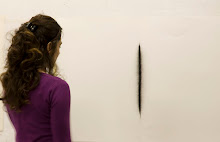The subject of flesh is dominant in the Baroque, where voluptous bodies or cascades of bodies and cloth create endless folds.
I see the baroque as the demand and desire of the flesh, or matter, to represent itself and expand into space. The Baroque celebrates the 'Flesh of the World'. It predates Merlau Ponty's vision of 'Flesh as a choreography between the flesh of the world and the flesh of the body'.
According to Giles Deleuze, writing in 'The Fold' about the Baroque, 'the world is interpreted as a body of infinite folds and surfaces that twist and weave through compressed time and space'
The Baroque is movement, and this is why it interests me.
Moving away from the idealism of the Renaissance it is more related to life and the turbulence and change it entails.
It is closer to my experience of my insides, my doubts, my desires.
The Baroque characterises a period of change and instability itself. So form communicates with reality.
A characteristic of the Baroque is excess. It is the excess of flesh that demands to assert its own self. Art moving closer and closer to life instead of an ideal representation of it.
The Baroque builds on the depth of pictorial space created by the Renaissance but adds to it the dimension of forwards. It is thus that its pulsating surface moves outwards to real space.
According to Giles Deleuze, writing in 'The Fold' about the Baroque, 'the world is interpreted as a body of infinite folds and surfaces that twist and weave through compressed time and space'
The Baroque is movement, and this is why it interests me.
Moving away from the idealism of the Renaissance it is more related to life and the turbulence and change it entails.
It is closer to my experience of my insides, my doubts, my desires.
The Baroque characterises a period of change and instability itself. So form communicates with reality.
A characteristic of the Baroque is excess. It is the excess of flesh that demands to assert its own self. Art moving closer and closer to life instead of an ideal representation of it.
The Baroque builds on the depth of pictorial space created by the Renaissance but adds to it the dimension of forwards. It is thus that its pulsating surface moves outwards to real space.
In the development of my recent work I have been inspired especially by the work of Rubens. And especially by the painting The Fall of the Rebel Angels. This painting for me represents at the same time the joy of experiencing flesh and the pain and suffering its breaking free entails.
 |
| Study for the Fall |










Δεν υπάρχουν σχόλια:
Δημοσίευση σχολίου